| Parvilux | |
|---|---|
| Scientific classification | |
| Kingdom: | Animalia |
| Phylum: | Chordata |
| Class: | Actinopterygii |
| Order: | Myctophiformes |
| Family: | Myctophidae |
| Genus: | Parvilux C. L. Hubbs & Wisner, 1964 |
| Species | |
See text. | |
Parvilux is a genus of lanternfishes.
| Parvilux | |
|---|---|
| Scientific classification | |
| Kingdom: | Animalia |
| Phylum: | Chordata |
| Class: | Actinopterygii |
| Order: | Myctophiformes |
| Family: | Myctophidae |
| Genus: | Parvilux C. L. Hubbs & Wisner, 1964 |
| Species | |
See text. | |
Parvilux is a genus of lanternfishes.
There are currently two recognized species in this genus: [2]

The Poeciliidae are a family of freshwater fishes of the order Cyprinodontiformes, the tooth-carps, and include well-known live-bearing aquarium fish, such as the guppy, molly, platy, and swordtail. The original distribution of the family was the Southeastern United States to north of Río de la Plata, Argentina, and Africa, including Madagascar. Due to release of aquarium specimens and the widespread use of species of the genera Poecilia and Gambusia for mosquito control, though, poeciliids can today be found in all tropical and subtropical areas of the world. In addition, Poecilia and Gambusia specimens have been identified in hot springs pools as far north as Banff, Alberta.

Gambusia is a large genus of viviparous fish in the family Poeciliidae. Gambusia contains over 40 species, most of which are principally found in freshwater habitats, though some species may also be found in brackish or saltwater habitats. The genus Gambusia comes from the Cuban term, "Gambusino", which means "free-lance miner". The type species is the Cuban gambusia, G. punctata. The greatest species richness is in Mexico, Texas, and the Greater Antilles, but species are also found elsewhere in the eastern and southern United States, the Bahamas, Central America, and Colombia. Gambusia species are often called topminnows, or simply gambusias; they are also known as mosquitofish, which, however, refers more specifically to two species, G. affinis and G. holbrooki, which are often introduced into ponds to eat mosquito larvae. As a consequence, they have been introduced widely outside their native range, and frequently become invasive, threatening local species. They are only occasionally kept in aquariums, due to their relative lack of color and the highly aggressive nature of the aforementioned mosquitofish species.

Etheostoma is a genus of small freshwater fish in the family Percidae native to North America. Most are restricted to the United States, but species are also found in Canada and Mexico. They are commonly known as darters, although the term "darter" is shared by several other genera. Many can produce alarm pheromones that serve to warn nearby fish in case of an attack.
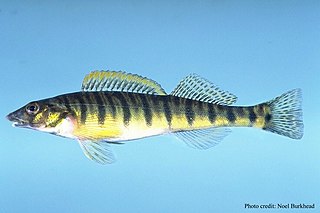
Percina is a genus of small freshwater ray-finned fish, classified within the subfamily Etheostomatinae, part of the family Percidae, which also contains the perches, ruffes and pikeperches from North America. Like the similar fishes in the genus Etheostoma, they are some species called "darters". More specifically, the genus as a whole is known as roughbelly darters, while certain species of Percina with a pattern of vertical bars on the flanks are called logperches.

Rasbora is a genus of fish in the family Cyprinidae. They are native to freshwater habitats in South and Southeast Asia, as well as southeast China. A single species, R. gerlachi, is only known from an old specimen that reputedly originated from Africa (Cameroon), but this locality is considered doubtful. They are small, up to 17 cm (6.7 in) long, although most species do not surpass 10 cm (4 in) and many have a dark horizontal stripe.

Lepidomeda is a genus of cyprinid fish, commonly known as the spinedaces, found in western North America. Of the four known species, one is extinct and two are threatened. They appear to be fairly close to the leatherside chub and the spikedaces, but the phylogeny and indeed the validity of the proposed "plagopterin" clade is insufficiently resolved.

Triodia is a large genus of tussock grass endemic to Australia. The species of this genus are known by the common name spinifex, although they are not a part of the coastal genus Spinifex. Many soft-leaved Tridoia species were formerly included in the genus Plectrachne. Triodia is known as tjanpi (grass) in central Australia, and have several traditional uses amongst the Aboriginal Australian peoples of the region.

Gadomus is a genus of rattails in the family Bathygadidae.
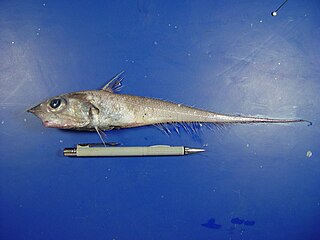
Nezumia is a genus of rattails. The generic name derives from the Japanese 鼠 (nezumi), meaning "mouse".
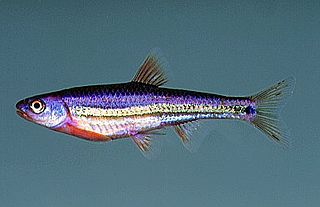
Notropis is a genus of freshwater fish in the family Cyprinidae. They are known commonly as eastern shiners. They are native to North America, and are the continent's second largest genus.

Erimystax is a genus of ray-finned fish in the family Cyprinidae. Members are commonly known as slender chubs, though "slender chub" is also used for individual species local to some area, particularly Erimystax cahni.
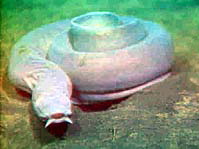
Eptatretus is a large genus of hagfish.

Myxine is a genus of hagfish, from the Greek μυξῖνος. It is the type genus of the class Myxini.

Iseilema, commonly known in Australia as Flinders grass, is a genus of Asian and Australian plants in the grass family.

Ichthyomyzon is a genus of northern lampreys in the sub-family Petromyzontinae, native to North America.
Entosphenus is a genus of lampreys.
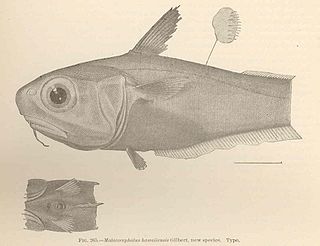
Malacocephalus is a genus of rattails.
Scomberesox is a genus of sauries. It is one of two in the family Scomberesocidae. The generic name Scomberesox is a he name id a compound of scomber, which in turn is derived from the Greek skombros, meaning "mackerel", and the Latin esox meaning pike.

Poeciliinae is a subfamily of killifish from the family Poeciliidae which contains species from the Americas which are collectively known as the livebearers because many, but not all, of the species within the subfamily are ovoviviparous.